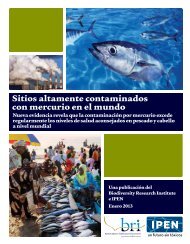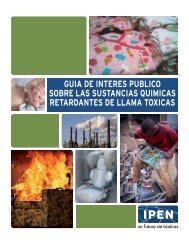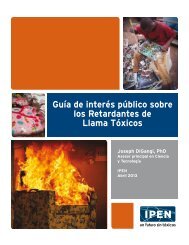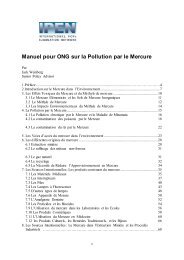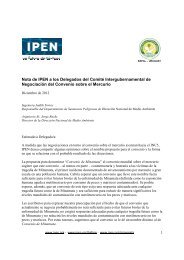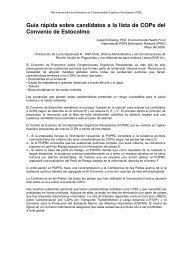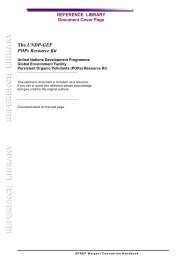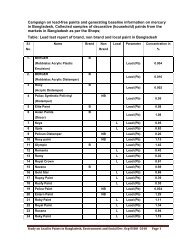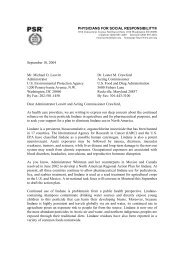A Public Interest Guide to Toxic Flame Retardant Chemicals
A Public Interest Guide to Toxic Flame Retardant Chemicals
A Public Interest Guide to Toxic Flame Retardant Chemicals
Create successful ePaper yourself
Turn your PDF publications into a flip-book with our unique Google optimized e-Paper software.
ations, <strong>to</strong> analyze how children might be<br />
exposed <strong>to</strong> DecaBDE. The industry used a<br />
very small sample of adults <strong>to</strong> incorrectly<br />
make conclusions about health risks <strong>to</strong><br />
children and then even dis<strong>to</strong>rted the findings<br />
from this small sample. The industry<br />
used data from 1988 which measured<br />
DecaBDE in the blood of just 12 adults and<br />
found that five contained the chemical<br />
and seven did not. The Chicago Tribune<br />
reports that when Exponent reported the<br />
results for the industry they, “…flipped the<br />
findings around, emphasizing the seven<br />
samples where none of the chemical was<br />
detected.” They claimed that since “the<br />
majority” of serum samples (of adults) did<br />
not contain DecaBDE, that the majority of<br />
the entire population had low “if not zero”<br />
exposure. Exponent also claimed that no<br />
further evaluation of DecaBDE was warranted<br />
despite relying on only 12 samples<br />
from adults <strong>to</strong> make this conclusion about<br />
children. Dennis Paustenbach was the Vice<br />
President of Exponent at the time and he<br />
went on <strong>to</strong> write a publication based on<br />
this small number of samples from adults<br />
for the now defunct Journal of Children’s<br />
Health – a publication edited by Paustenbach.<br />
The journal folded a few months<br />
after publishing the “study”.<br />
4.6 OTHER CHEMICALS MARKETED<br />
AS FLAME RETARDANTS HAVE<br />
TOXIC CHARACTERISTICS THAT<br />
RAISE CONCERNS<br />
Overall, <strong>to</strong>xic chemicals marketed as flame<br />
retardants lack adequate <strong>to</strong>xicity information.<br />
However, the information that is available<br />
has raised concerns. For example, the<br />
San An<strong>to</strong>nio Statement notes a variety of<br />
harmful characteristics (see abbreviations<br />
list at the end of this document). HBCD<br />
used in insulation (Hexabromocyclododecane)<br />
is very <strong>to</strong>xic <strong>to</strong> aquatic organisms and<br />
can disrupt the hypothalamic-pituitarythyroid<br />
(HPT) axis, disrupting normal<br />
development, affecting the central nervous<br />
system, and inducing reproductive and<br />
developmental effects in mammals with<br />
some of them being trans-generational.<br />
Dechlorane Plus is used for coating electrical<br />
wires and cables, connec<strong>to</strong>rs used<br />
in computers, and plastic roofing material.<br />
Dechlorane Plus is poorly characterized<br />
<strong>to</strong>xicologically; however it resembles<br />
chlordane, dieldrin, endosulfan, endrin,<br />
and heptachlor – all substances listed<br />
in the S<strong>to</strong>ckholm Convention for global<br />
elimination. BTBPE is used in plastics and<br />
its metabolite, 2, 4, 6-tribomophenol, is a<br />
thyroid disrupting chemical found in umbilical<br />
cord blood. TBECH (1, 2-Dibromo-4-(1,<br />
2-dibromoethyl) cyclohexane) is used<br />
in home insulation, cables, plastics, and<br />
adhesives and is mutagenic <strong>to</strong> mammalian<br />
cells. PBEB (Pentabromoethylbenzene) is<br />
used in polymers and is poorly characterized<br />
<strong>to</strong>xicologically but the substance is a<br />
brominated analogue of ethyl benzene, a<br />
carcinogen. TBBPA (Tetrabromobisphenol<br />
A) is used in electronics, is structurally<br />
similar <strong>to</strong> thyroxin, shows thyroid hormone<br />
activity in vivo and in vitro, has estrogenic<br />
activity, and inhibits neurotransmitter uptake.<br />
TCEP (Tris (2-chloroethyl) phosphate)<br />
has been used in foam for furniture and<br />
A PUBLIC INTEREST GUIDE TO TOXIC FLAME RETARDANT CHEMICALS<br />
9



